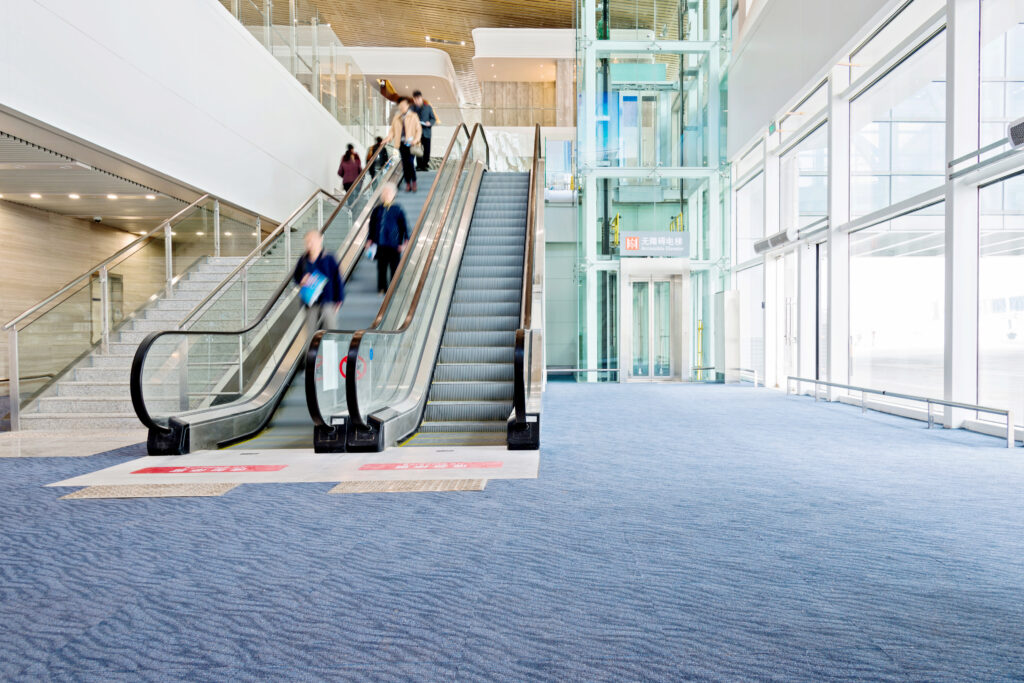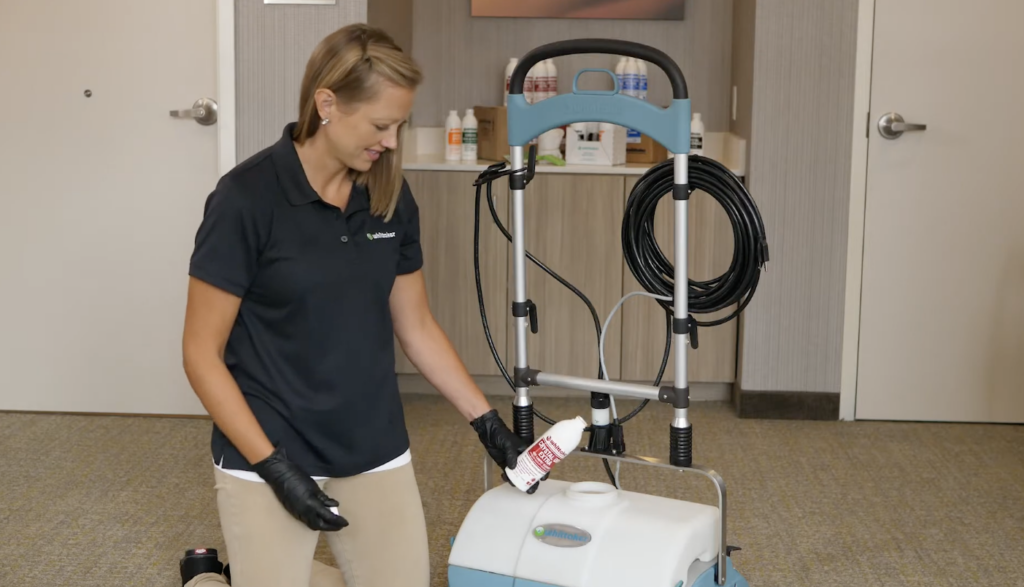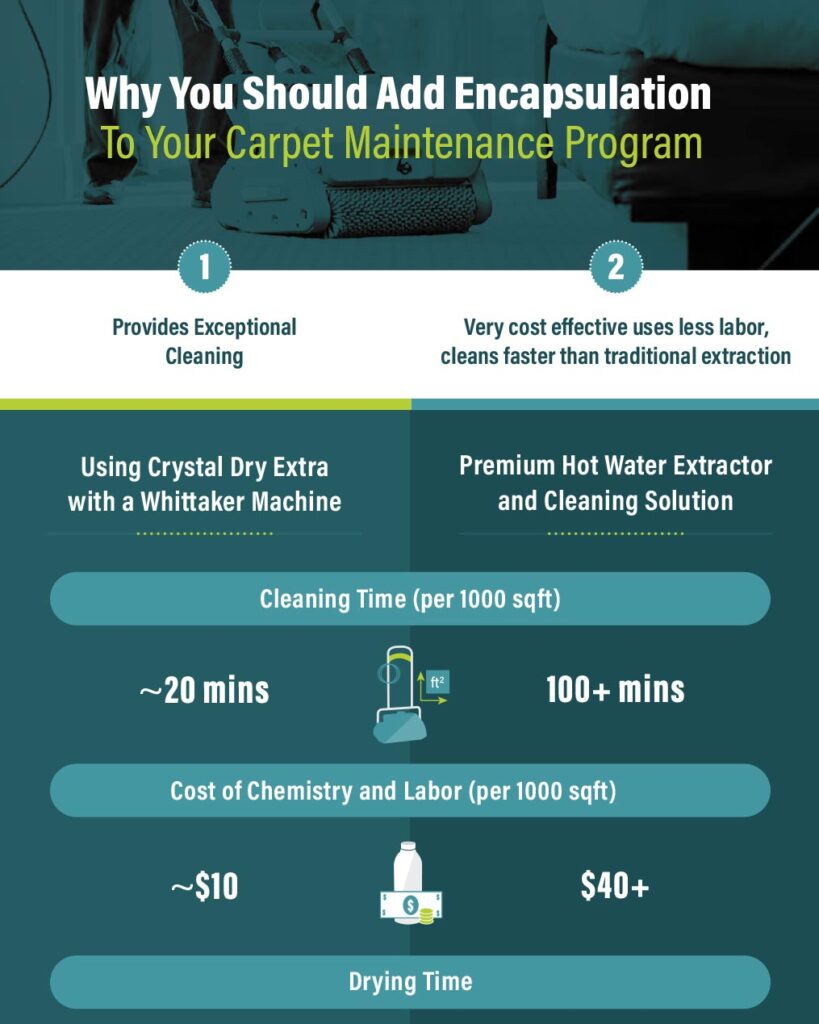Discover how you can keep your carpets looking amazing with the best carpet cleaning method on the market.
There are countless techniques and products out there, each claiming to provide superior results. But how do you know which one is truly the best solution for your commercial carpet cleaning needs? Different methods may work better for different types of carpets or levels of dirtiness.
To make an informed decision about the best carpet cleaning method, it’s essential to explore various options and weigh their pros and cons. Today, we’re going to be giving you an in-depth look into hot water extraction and low-moisture cleaning techniques to determine the best carpet cleaning method once and for all. Curious about the results? Keep reading!
How Does Hot Water Extraction Carpet Cleaning Work?
Though it is a popular method for carpet cleaning—hot water extraction is a big undertaking.
Hot water extraction—also known as steam cleaning—is a popular professional carpet cleaning method. It combines high-temperature water and powerful suction to effectively dislodge dirt particles embedded deep within your carpets.
This process begins with applying a pre-conditioning agent on your carpets’ surface. The agent helps break down soil particles for easy removal during the next steps of your carpet cleaning service. The next step involves injecting heated water mixed with an appropriate detergent into your carpet pile under pressure.
The heat from the water aids in releasing trapped grime while activating the detergents. After allowing some time for the cleaning agent to take effect, industrial-grade vacuum units extract dirty liquid and loosened dirt particles from your carpets.
Temperature During Steam Cleaning
Maintaining proper temperature levels throughout this procedure is essential. High temperatures increase solubility rates helping dissolve stubborn soils more efficiently. That’s why it’s often referred to as ‘steam’ cleaning despite not actually involving any steam. Research has shown a correlation between increased heat levels during carpet shampooing and improved allergen reduction rates. Beyond enhancing detergents’ efficiency by reducing their viscosity, higher temperatures can kill off bacteria or mites present in your carpets. This leads to better indoor air quality post-cleaning.
Preventing Oversaturation & Facilitating Quick Drying Times
The key function of hot-water extraction methods is extracting spent fluids along with dislodged contaminants with strong suction power. Leaving excess moisture behind could lead to potential issues such as mold growth, unpleasant odors, or even damage to underlying structures like subfloors over time.
An efficient wet-vacuum system should be capable enough to remove most residual dampness shortly after completion so that drying times remain minimal without compromising cleanliness standards. However, this is not always the case—that’s why it is important to introduce low-moisture cleaning practices into your protocol as well.
Key Benefits and Drawbacks of Hot Water Extraction Carpet Cleaning
While hot water extraction is one of the best carpet cleaning methods for a deep clean, there are other options out there for appearance management

The professional carpet cleaning world is divided between two main methods—hot water extraction and low-moisture encapsulation. Let’s take a look at why hot water extraction is important but isn’t recommended for use more than once or twice per year
The Advantages of Hot Water Extraction for Carpets
This method uses heated water to loosen dirt particles trapped deep within the carpet pile. The high temperatures also kill bacteria and allergens, making it an effective choice for maintaining clean carpets in facilities like hotels or schools where hygiene standards are paramount.
In addition to improving aesthetic appeal through stain removal, this technique helps prolong your investment by eliminating abrasive particles that degrade the fibers over time. The process keeps your carpet clean while also preserving the longevity of commercial carpets. This is a critical factor when considering the cost implications associated with frequent replacements.
Potential Risks Associated With Steam Cleaning
While there are many benefits to using hot-water extraction as part of your professional carpet maintenance toolkit, it is important to remember the risks as well. This method requires careful handling of moisture levels during the process to prevent mold growth due to prolonged dampness. A damp or moldy carpet is sure to lead to complaints, which is a big problem for any commercial space.
Additionally, certain types of delicate materials used to manufacture carpets might react adversely to the high-temperature conditions involved in steam-cleaning operations. In these instances, alternative techniques need to be employed to protect the texture and color integrity of these rugs while still ensuring a thorough cleanse according to CRI guidelines.
Cost Considerations for Frequent Use of Hot-Water Extraction
One significant drawback of deploying this strategy is due to expense. Intensive treatment consumes more resources in terms of labor and supplies compared to lighter maintenance procedures like low-moisture carpet cleaning. That’s why businesses must cautiously assess the affordability of using hot-water extraction too often.
Introduction to Low-Moisture Encapsulation Carpet Cleaning
Low-moisture techniques are the best carpet cleaning methods for maintenance in between deep cleans

Recently, low-moisture encapsulation has been gaining popularity in the professional carpet cleaning industry. This cleaning process which is commonly employed in places such as hotels and schools, is renowned for its effectiveness, efficiency, and safety.
What Is Low-Moisture Carpet Cleaning?
This technique involves using specialized chemicals that surround or ‘encapsulate’ oily soil particles left behind after vacuuming. Once dried, these encased dirt particles are removed with routine vacuuming. Unlike traditional wet cleaning methods like hot water extraction, this approach requires less moisture and provides a quicker turnaround.
A notable association with low-moisture carpet cleaning is its ability to prevent re-soiling by trapping loosened abrasive dirt particles inside crystallized polymers rather than leaving them on the surface.
How Often Should I Use Low-Moisture Carpet Cleaning?
How often you should conduct low-moisture encapsulation depends on various factors, including foot traffic levels and soiling rates. High-traffic areas, like hotel lobbies, may need frequent cleanings compared to less heavily trafficked spaces.
While high-traffic areas require low-moisture carpet cleaning every month, areas that see less foot traffic only require low-moisture cleaning every 2-3 months.
In addition to these considerations, environmental conditions such as humidity levels also play a crucial role in determining how often carpets are cleaned. In regions with higher humidity, carpets might attract more dampness-related soils, which will require a higher cleaning frequency than drier areas.
So, Which is the Best Carpet Cleaning Method?
Low-moisture carpet cleaning offers several advantages compared to other common carpet cleaning techniques. For starters, there’s less risk of over-wetting, given minimal use of water, which means faster drying periods. This makes low moisture practices an ideal solution for establishments needing quick results.
However, it is important to remember that hot water extraction is still necessary every so often to get the best results for our commercial space.
How Does Low-Moisture Encapsulation Carpet Cleaning Work?
Low-moisture encapsulation is a technique that uses special polymers that envelop and isolate dirt particles
Crystallizing polymers are the key to low-moisture encapsulation chemistry. These compounds work by encapsulating or encasing loosened dirt particles within their unique crystal structure as they dry. The key advantage here is their ability to transform soil into non-sticky crystals.
This transition from sticky residue to easily removable crystals occurs when the encapsulation solution dries upon contact with carpet fibers and soil. As it dries, it forms distinct crystal structures around each particle of grime or dirt, separating them from other material components.
In practice, these crystallized residues are removed simply through routine vacuuming without causing any harm to your carpets’ pile and color vibrancy when using the proper chemistry.
Striking the Right Balance: Hot Water Extraction and Low-Moisture Carpet Cleaning Techniques
What is the best carpet cleaning method? A combination of hot water extraction and low-moisture carpet cleaning
The art of commercial carpet cleaning is not a one-size-fits-all approach. It’s about understanding your facility’s needs, foot traffic levels, and budget constraints with the right schedule of leveraging hot water extraction and low-moisture cleaning techniques, you can keep your facility’s carpets pristine.
When Should Each Technique Be Used?
Your choice between hot water extraction or low-moisture encapsulation depends on the state of your carpets. If you’re dealing with heavily soiled or stained areas that require deep clean treatments, then hot water extraction might be just what you need.
In contrast, if light soiling is an issue and a quick re-entry to cleaned spaces is desired, consider opting for the low-moisture technique. It reduces the risks associated with over-wetting, such as mold growth and shrinkage, making it ideal for regular upkeep in high-traffic zones.
The Best Carpet Cleaning Method: Merging Both Techniques
In many cases, combining these two professional carpet cleaning methods strategically can yield the best outcomes. Regular scheduled surface-level dirt control via low-moisture treatments with periodic deeper cleans through hot-water extractions ensures soils don’t accumulate over time. This balanced approach helps prolong the lifespan of the carpet and lowers replacement costs in the long run.
A good rule of thumb is to schedule annual, biannual, or quarterly extractions complemented by monthly encapsulation treatments. You can adjust the frequency based on observed wear and tear patterns in specific areas within the facility. For example, entrance lobbies likely require more frequent cleaning than a conference room. It is also very important to maintain entrances in order to keep soil from being tracked through the rest of the facility.

The Impact of Clean Carpets on Guest Satisfaction
Beyond improving the lifespan of your carpet, regular low-moisture cleaning will improve guest experience at your business
The importance of clean carpets in maintaining guest satisfaction across various types of facilities, such as hotels, long-term care centers, and schools, cannot be overstated. A well-maintained carpet not only enhances the aesthetic appeal but also reflects your commitment to hygiene and cleanliness.
Carpet Cleanliness and Customer Contentment
A clean carpet is more than just a pleasing sight—it directly influences how guests perceive their overall experience at your facility. For instance, walking into a hotel lobby with freshly cleaned and spotless carpets instantly creates an impression of luxury and meticulous maintenance.
In contrast, unclean or stained carpets can raise questions about the overall cleanliness standards maintained by management. This could potentially tarnish your reputation among customers who value hygiene above all else.
FAQs in Relation to the Best Carpet Cleaning Method
What is the best method of cleaning the carpet?
The most effective method for maintaining carpets long-term, especially in commercial spaces, is a combination of low-moisture encapsulation and hot water extraction.
What are the three most common ways to clean carpets?
The three most common methods are hot water extraction, dry cleaning, and low-moisture encapsulation.
What are the 6 types of carpet cleaning methods?
Six popular methods include Hot Water Extraction, Dry Cleaning, Encapsulation, Bonnet Cleaning, Shampooing, and Absorbent Compound Cleaning.
Hot water extraction and low-moisture encapsulation have their unique strengths in carpet cleaning. Hot water extraction, while effective, may be costly and potentially risky with frequent use. On the other hand, low-moisture methods offer cost-effectiveness, sustainability, and safety for regular maintenance. A balance between these two techniques offers an optimal solution to keep commercial carpets pristine based on factors like foot traffic or budget constraints.If you’re ready to invest in the best carpet cleaning method that suits your needs, consider exploring our range of commercial carpet cleaning machines and low-moisture cleaning chemistry at Whittaker. Our products ensure maximum cleanliness without compromising on quality or efficiency. Explore our range of products and learn more about how we can help enhance your facility’s appearance and customer satisfaction through superior carpet care solutions. Shop our CRYSTAL DRY® Chemistry today to discover the Whittaker difference!

